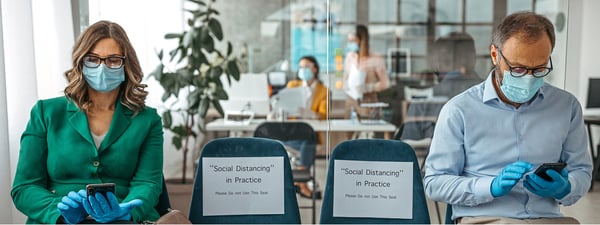 Trend penurunan kasus COVID-19 yang relatif stabil dan pelonggaran pembatasan aktivitas menjadi angin segar bagi dunia industri. Sebagian besar sektor bisnis sudah mulai mengambil ancang-ancang untuk langsung tancap gas begitu pemerintah memberikan lampu hijau. Perubahan yang akan terasa paling signifikan adalah kembalinya karyawan secara fisik ke tempat kerja yang sering disebut work from office (WFO).
Trend penurunan kasus COVID-19 yang relatif stabil dan pelonggaran pembatasan aktivitas menjadi angin segar bagi dunia industri. Sebagian besar sektor bisnis sudah mulai mengambil ancang-ancang untuk langsung tancap gas begitu pemerintah memberikan lampu hijau. Perubahan yang akan terasa paling signifikan adalah kembalinya karyawan secara fisik ke tempat kerja yang sering disebut work from office (WFO).
Untuk menghadapi WFO, pastinya banyak persiapan yang perlu dilakukan oleh perusahaan. Strateginya bervariasi, mulai dari pengaturan giliran WFH/WFO, penyediaan transportasi antar jemput, penetapan protokol screening dan pencatatan khusus saat memasuki area kerja, dan pembatasan penggunaan ruang komunal. Namun, sering luput dari perhatian kita adalah manajemen kualitas udara dalam ruangan (indoor air quality/IAQ) di area kerja.
IAQ menjadi krusial dalam manajemen COVID-19 di tempat kerja karena sifat COVID-19 yang menular melalui droplet dan aerosol. Banyak studi menunjukkan bahwa risiko dan kejadian penularan pada setting indoor secara signifikan lebih tinggi akibat akumulasi partikel yang terjebak di dalam ruangan. Pada beberapa kasus, partikel yang mengandung virus SARS-CoV-2 ini malah dapat bertahan secara berjam-jam di udara (airborne). Maka itu, tidak heran kalau sering sekali kita mendengar berita munculnya klaster perkantoran ataupun klaster sekolah. Bahkan, salah satu serikat pekerja menyatakan bahwa klaster pabrik termasuk klaster penyebaran COVID-19 yang paling agresif.
Untuk menurunkan risiko transmisi COVID-19 dalam setting ruang tertutup, dibutuhkan pertukaran udara yang adekuat untuk membuang droplet maupun aerosol yang mengandung virus. Suplai udara ini dapat bersumber dari udara luar maupun udara resirkulasi yang difilter. Banyak faktor yang mempengaruhi kebutuhan suplai udara, antara lain ukuran ruangan, tingkat okupansi, maupun jenis aktivitas yang dilakukan di dalam ruangan. Ketika sistem ventilasi yang sudah ada tidak dapat mengakomodasi kebutuhan suplai udara, maka alternatifnya adalah menggunakan filter udara portabel atau melakukan modifikasi flow udara indoor. Selain manajemen risiko dalam bidang engineering, pengaturan administratif juga diperlukan untuk memastikan sistem ventilasi berfungsi maksimal menurunkan risiko transmisi COVID-19. Misalnya, pengaturan durasi operasional AC sampai kepatuhan prosedur perawatan alat.
Pelonggaran kegiatan masyarakat memang dilakukan secara bertahap agar tidak muncul gelombang ketiga. Momen ini juga menjadi kesempatan berharga bagi dunia usaha untuk beradaptasi dengan kenormalan baru agar dapat menciptakan tempat kerja yang aman dari COVID-19, salah satunya melalui manajemen IAQ. Dengan pengaturan IAQ yang baik bersama dengan penerapan protokol kesehatan secara konsisten, kita dapat turut serta dalam percepatan pemulihan ekonomi nasional.
Ketahui dan hubungi kami mengenai Manajemen Indoor Air Quality disini.
Indoor Air Quality Management for COVID-19 Prevention in the Workplace
The relatively stable downward trend in CovOVID-19 cases and the easing of activity restrictions have become a breath of fresh air for the industrial world. Most business sectors have begun to take steps to step on the gas as soon as the government gives the green light. The most significant change will be the physical return of employees to the workplace which is often called work from office (WFO).
To deal with WFO, of course, many preparations need to be done by the company. The strategies vary, ranging from setting up WFH/WFO shifts, providing shuttle transportation, establishing screening protocols and special records when entering the work area, and limiting the use of communal spaces. However, what often escapes our attention is the management of indoor air quality (IAQ) in the work area.
IAQ is crucial in the management of COVID-19 in the workplace because of the nature of COVID-19 which is transmitted through droplets and aerosols. Many studies show that the risk and incidence of transmission in indoor settings is significantly higher due to the accumulation of particles trapped in the room. In some cases, particles containing the SARS-CoV-2 virus can even survive for hours in the air (airborne). Therefore, it is not surprising that we often hear news about the emergence of office clusters or school clusters. In fact, one of the worker unions stated that the factory cluster was the most aggressive cluster of COVID-19 spread.
To reduce the risk of COVID-19 transmission in a closed room setting, adequate air exchange is required to dispose of droplets and aerosols containing the virus. This air supply can be sourced from outside air or filtered recirculated air. Many factors affect the need for air supply, including the size of the room, the occupancy rate, and the types of activities carried out in the room. When the existing ventilation system cannot accommodate the need for air supply, the alternative is to use a portable air filter or modify the indoor air flow. In addition to risk management in engineering, administrative arrangements are also needed to ensure the ventilation system functions optimally to reduce the risk of COVID-19 transmission. For example, setting the duration of AC operation, to compliance with equipment maintenance procedures.
The easing of community activities are carried out gradually so that a third wave does not appear. This moment is also a valuable opportunity for the business world to adapt to the new normal in order to create a workplace that is safe from COVID-19, one of which is through the management of IAQ. With a good IAQ arrangement along with the consistent application of health protocols, we can participate in accelerating the national economic recovery.
Find out and contact us about Indoor Air Quality Management here.


